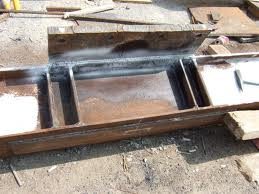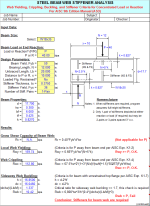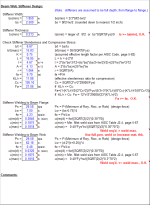STIFFNER.xls

Description
"STIFFNER" is a spreadsheet program written in MS-Excel for the purpose of analysis of steel beams subject to concentrated loads. Specifically, web yielding, web crippling, and web buckling criteria are checked to determine if web stiffeners are required to resist the concentrated load. If stiffeners are required, the stiffener size and weld requirements are determined.
This program is a workbook consisting of three (3) worksheets, described as follows:
- Doc - Documentation sheet
- Beam Stiffeners - Steel beam web stiffener analysis for concentrated loads
- Beam Stiffeners (Table) - Steel beam web stiffener analysis for concentrated loads (table version)
Program Assumptions and Limitations:
1. This program follows the procedures and guidelines of the AISC 9th Edition Allowable Stress (ASD) Manual for wide flange beams subjected to concentrated compressive loads per Chapter K, pages 5-80 to 5-83.
2. This program uses the database of member dimensions and section properties from the "AISC Shapes Database", Version 3.0 (2001) as well as the AISC 9th Edition (ASD) Manual (1989).
3. For the purpose of determining the total composite section to be considered for resisting the compressive load, the program assumes a spacing of 3" center-to-center between the stiffener pairs. Thus the total effective strips of web to be included in the composite section along with the stiffeners are as follows:
For interior condition (P or R > d/2):
1-pair:25*tw
2-pairs: 25*tw+3"
3-pairs: 25*tw+6"
For end condition (P or R <= d/2):
1-pair:12*tw
2-pairs: 12*tw+3"
3-pairs: 12*tw+6"
4. This program contains numerous “comment boxes” which contain a wide variety of information including explanations of input or output items, equations used, data tables, etc. (Note: presence of a “comment box” is denoted by a “red triangle” in the upper right-hand corner of a cell. Merely move the mouse pointer to the desired cell to view the contents of that particular "comment box".)
Calculation Reference
AISC
Structural Steel Design
Steel Designers Manual
Calculation Preview
Full download access to any calculation is available to users with a paid or awarded subscription (XLC Pro).
Subscriptions are free to contributors to the site, alternatively they can be purchased.
Click here for information on subscriptions.
Comments: 10
×
17 years ago
In the "STIFFNER.xls" workbook, again the calculation for the total length of the weld for connecting a pair of stiffeners to the beam flange should only have considered the welds on the near side (closest to the applied loading or end reaction), and not on both ends of the stiffeners, as had been done. This problem was corrected in both the "Beam Stiffeners" and the "Beam Stiffeners (Table)" worksheets. I also removed the input data validation for the steel yield strengths, which had previously limited the values that could be selected for input. This updated workbook is now version 2.5.
17 years ago
Alex,
To start, thank you. Your spreadsheets are top notch.
One question concerning the weld length of the stiffener to the flange. I'm assuming this is the required weld of the stiffeners to flange as not to require mill to bear stiffeners. If this is true, the Ps load must travel thru only the welds at the loaded flange (and not include the weld at the other flange). I think your calculations are doubleing the length avaialable. Example: 1 pair of stiffeners, 5.5" wide (W36x160 beam) should produce (5.5"-0.75") x 2 stiffeners x 2 weld sides = 19" right? The spreadsheet is reporting 38" of weld.
Your take on the subject?
Lastly to discuss the calculation of Ps load, this may be a personal choice but I think the load going into the stiffeners would more be based on effective bearing area (web strip plus stiffener area) as opposed to simply subtracting the allowed load into the web directly. I could be all washed up on the subject, is there some area in AISC or other code that pointed you in this direction?
Thanks in advance
Joe Knapp
To start, thank you. Your spreadsheets are top notch.
One question concerning the weld length of the stiffener to the flange. I'm assuming this is the required weld of the stiffeners to flange as not to require mill to bear stiffeners. If this is true, the Ps load must travel thru only the welds at the loaded flange (and not include the weld at the other flange). I think your calculations are doubleing the length avaialable. Example: 1 pair of stiffeners, 5.5" wide (W36x160 beam) should produce (5.5"-0.75") x 2 stiffeners x 2 weld sides = 19" right? The spreadsheet is reporting 38" of weld.
Your take on the subject?
Lastly to discuss the calculation of Ps load, this may be a personal choice but I think the load going into the stiffeners would more be based on effective bearing area (web strip plus stiffener area) as opposed to simply subtracting the allowed load into the web directly. I could be all washed up on the subject, is there some area in AISC or other code that pointed you in this direction?
Thanks in advance
Joe Knapp
17 years ago
Amon,
What you have to do is unprotect the worksheet and unhide the calculation columns. Just in case you are not sure how to do this, from the top tool bar select "Tools", "Protection", then "Unprotect Sheet". To unhide the columns, first highlight the 2 columns that contain the hidden columns (such as I and AF). Then from the top toolbar select "Format", "Column", and the "Unhide".
The properties database is found by scrolling to the right. You could then insert/replace your own desired shape designations and properties in that table. You would most likely want to edit the VLOOKUP commands under "Beam Properties" of the calculation page to reflect how many shapes you actually have in your new table.
Hope this helps.
Alex
What you have to do is unprotect the worksheet and unhide the calculation columns. Just in case you are not sure how to do this, from the top tool bar select "Tools", "Protection", then "Unprotect Sheet". To unhide the columns, first highlight the 2 columns that contain the hidden columns (such as I and AF). Then from the top toolbar select "Format", "Column", and the "Unhide".
The properties database is found by scrolling to the right. You could then insert/replace your own desired shape designations and properties in that table. You would most likely want to edit the VLOOKUP commands under "Beam Properties" of the calculation page to reflect how many shapes you actually have in your new table.
Hope this helps.
Alex
17 years ago
The spreadsheet is great!. It will prove to be a great help as I peform this particular calc many times. The only glitch for me is that I use metric steel sections. How do I modify the sections library and insert Australian metric sections.
17 years ago
Thank you, Alex, for consistantly great spreadsheets. They are beautifully set up, and very relevent for designers grinding out the basic, day-to-day calcs. Nick Barnitz, PE
17 years ago
Thank you, Alex, for consistantly great spreadsheets. They are beautifully set up, and very relevent for designers grinding out the basic, day-to-day calcs.
Nick Barnitz, PE
Nick Barnitz, PE
17 years ago
Alex Tomanovich's spreadsheets have kept me in the engineering business. When the wind, seismic and snow loadings became exponentially more complicated, I was lost. Because of Alex, I am able to cope. Thanks Alex! John P. Riley, SE Riley Engineering Blue Grass, Iowa 52726
17 years ago
Alex Tomanovich's spreadsheets have kept me in the engineering business. When the wind, seismic and snow loadings became exponentially more complicated, I was lost. Because of Alex, I am able to cope.
Thanks Alex!
John P. Riley, SE
Riley Engineering
Blue Grass, Iowa 52726
Thanks Alex!
John P. Riley, SE
Riley Engineering
Blue Grass, Iowa 52726
17 years ago
In the "STIFFNER.xls" workbook, a glitch was brought to my attention. A good while ago I had made the revision in calculating the stiffener width (bs) to round it down to the nearest 1/2". In the calculation of the total weld length (Lw) for attaching the stiffener to the beam flange, I was using the actual unrounded stiffener length and not the rounded down stiffener length. This has now been corrected.



By the way, the reason that I did not show the 12 is that it would not fit in the alloted space.